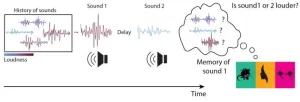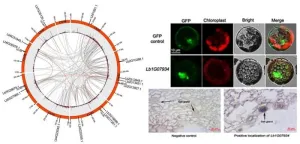(Press-News.org) Robotics engineers have worked for decades and invested many millions of research dollars in attempts to create a robot that can walk or run as well as an animal. And yet, it remains the case that many animals are capable of feats that would be impossible for robots that exist today.
“A wildebeest can migrate for thousands of kilometres over rough terrain, a mountain goat can climb up a literal cliff, finding footholds that don't even seem to be there, and cockroaches can lose a leg and not slow down,” says Dr. Max Donelan, Professor in Simon Fraser University’s Department of Biomedical Physiology and Kinesiology. “We have no robots capable of anything like this endurance, agility and robustness.”
To understand why, and quantify how, robots lag behind animals, an interdisciplinary team of scientists and engineers from leading research universities completed a detailed study of various aspects of running robots, comparing them with their equivalents in animals, for a paper published in Science Robotics. The paper finds that, by the metrics engineers use, biological components performed surprisingly poorly compared to fabricated parts. Where animals excel, though, is in their integration and control of those components.
Alongside Donelan, the team comprised Drs. Sam Burden, Associate Professor in the Department of Electrical & Computer Engineering at the University of Washington; Tom Libby, Senior Research Engineer, SRI International; Kaushik Jayaram, Assistant Professor in the Paul M Rady Department of Mechanical Engineering at the University of Colorado Boulder; and Simon Sponberg, Dunn Family Associate Professor of Physics and Biological Sciences at the Georgia Institute of Technology.
The researchers each studied one of five different “subsystems” that combine to create a running robot – Power, Frame, Actuation, Sensing, and Control – and compared them with their biological equivalents. Previously, it was commonly accepted that animals’ outperformance of robots must be due to the superiority of biological components.
“The way things turned out is that, with only minor exceptions, the engineering subsystems outperform the biological equivalents – and sometimes radically outperformed them,” says Libby. “But also what's very, very clear is that, if you compare animals to robots at the whole system level, in terms of movement, animals are amazing. And robots have yet to catch up.”
More optimistically for the field of robotics, the researchers noted that, if you compare the relatively short time that robotics has had to develop its technology with the countless generations of animals that have evolved over many millions of years, the progress has actually been remarkably quick.
“It will move faster, because evolution is undirected,” says Burden. “Whereas we can very much correct how we design robots and learn something in one robot and download it into every other robot, biology doesn't have that option. So there are ways that we can move much more quickly when we engineer robots than we can through evolution – but evolution has a massive head start.”
More than simply an engineering challenge, effective running robots offer countless potential uses. Whether solving ‘last mile’ delivery challenges in a world designed for humans that is often difficult to navigate for wheeled robots, carrying out searches in dangerous environments or handling hazardous materials, there are many potential applications for the technology.
The researchers hope that this study will help direct future development in robot technology, with an emphasis not on building a better piece of hardware, but in understanding how to better integrate and control existing hardware. Donelan concludes, “As engineering learns integration principles from biology, running robots will become as efficient, agile, and robust as their biological counterparts.”
END
Why can’t robots outrun animals?
2024-04-24
ELSE PRESS RELEASES FROM THIS DATE:
After spinal cord injury, neurons wreak havoc on metabolism
2024-04-24
COLUMBUS, Ohio – Conditions such as diabetes, heart attack and vascular diseases commonly diagnosed in people with spinal cord injuries can be traced to abnormal post-injury neuronal activity that causes abdominal fat tissue compounds to leak and pool in the liver and other organs, a new animal study has found.
After discovering the connection between dysregulated neuron function and the breakdown of triglycerides in fat tissue in mice, researchers found that a short course of the drug gabapentin, commonly prescribed for nerve pain, prevented ...
Network model unifies recency and central tendency biases
2024-04-24
Neuroscientists have revealed that recency bias in working memory naturally leads to central tendency bias, the phenomenon where people’s (and animals’) judgements are biased towards the average of previous observations. Their findings may hint at why the phenomenon is so ubiquitous.
Researchers in the Akrami Lab at the Sainsbury Wellcome Centre at UCL and the Clopath Lab at Imperial College London developed a network model with a working memory module and another accounting for sensory histories. The study, published in eLife, describes how the model shows neural circuits ...
Ludwig Lausanne scientists identify and show how to target a key tumor defense against immune attack
2024-04-24
April 24, 2024, NEW YORK – A Ludwig Cancer Research study has discovered how a lipid molecule found at high levels within tumors undermines the anti-cancer immune response and compromises a recently approved immunotherapy known as adoptive cell therapy (ACT) using tumor infiltrating lymphocytes, or TIL-ACT. In this individualized cell therapy, TILs—CD8+ T cells that kill cancer cells—are expanded in culture from a patient’s tumor samples and reinfused into the patient as a treatment.
Researchers led by Ludwig Lausanne’s Matteo ...
Can climate change accelerate transmission of malaria? Pioneering research sheds light on impacts of temperature
2024-04-24
In 2022, an estimated 249 million malaria cases killed 608,000 people in 85 countries worldwide including the United States, according to the World Health Organization.
Malaria continues to pose a considerable public health risk in tropical and subtropical areas, where it impacts human health and economic progress.
Despite concerns about the potential impact of climate change on increasing malaria risk, there is still limited understanding of how temperature affects malaria transmission – until now.
Malaria is a mosquito-borne disease caused by a parasite that spreads from bites of infected female Anopheles mosquitoes. If left untreated in humans, malaria can cause severe symptoms, ...
A new attempt to identify salt gland development and salt resistance genes of Limonium bicolor ——Identification of bHLH gene family and its function analysis in salt gland development
2024-04-24
The secondary salinization of saline-alkali land is increasing globally. It is of strategic significance to explore the salt-tolerant molecular mechanism of halophytes and cultivate saline-alkali resistant crops for the improvement of saline-alkali land. The recretohalophyte Limonium bicolor has a unique salt-secreting structure, salt gland, which can directly excrete Na+ out of the body to effectively avoid salt stress. Exploring the development mechanism of salt gland structure in recretohalophyte is of great significance for analyzing the development of plant epidermis structure and improving the salt-resistant mechanism of plants.
Recently, Wang ...
The SAPIENS Podcast named finalist at the 16th Annual Shorty Awards
2024-04-24
SAPIENS: A Podcast for Everything Human has been named as a 16th Annual Shorty Awards finalist in the Science and Technology Podcast Category.
The Shorty Awards honor the best work in digital and social media by the most creative and influential brands, agencies, organizations, and individuals whose work has excelled in creativity, strategy, and effectiveness.
SAPIENS’s work has demonstrated outstanding performance across the judging criteria, which makes it a top contender for a Shorty Award in a most competitive year. The work is also eligible for ...
Startup financing gender gaps greater in societies where women are more empowered
2024-04-24
Commercial bankers provide capital to fund the operations and growth of businesses. However, as these lenders evaluate entrepreneurs who apply for loans, gender bias leads to women being denied more often than their male counterparts.
Estimates show a $1.7 trillion financing gap worldwide for small- and medium-sized enterprises owned by women.
Studies show that when women do secure business loans, the amounts tend to be smaller, have higher interest rates and require more collateral, which restricts the economic potential of women-led ventures. However, findings ...
Postpartum depression after adolescent stress shows a dysregulated HPA axis: a cross-species translational study
2024-04-24
BIRMINGHAM, Ala. – Adverse life events are a known and predominant risk factor for postpartum depression in women after delivery of their baby. Furthermore, the postpartum depression in women who have experienced adverse life events tends to be refractory to treatment.
In a study using a mouse model and human subjects, researchers from the University of Alabama at Birmingham and Johns Hopkins Medicine show that stress from adolescent social isolation in mice elicits a prolonged elevation of corticosterone levels and glucocorticoid signaling, which in turn results ...
When studies conflict: building a decision-support system for clinicians
2024-04-24
One day you hear that red wine is good for your heart. The next day, it’s not. The same goes for chocolate. And coffee. The see-saw of contradicting information isn’t anything new, but what happens when clinicians hear conflicting studies about a medication they use for their patients? Researchers at the Perelman School of Medicine at the University of Pennsylvania are hoping to use, among other methods, a variety of artificial intelligence to help sort that out.
Ellen Caniglia, ScD, an assistant professor of Epidemiology and Enrique Schisterman, PhD, a professor and the chair of the Department of Biostatistics, Epidemiology, and Informatics (DBEI), ...
Artificial sweetener has potential to damage gut
2024-04-24
New research has discovered that neotame, one of the new generation of artificial sweeteners, is capable of damaging the human intestine and causing illness.
The study is the first to show that neotame can cause previously healthy gut bacteria to become diseased and invade the gut wall – potentially leading to health issues including irritable bowel syndrome and sepsis – and also cause a breakdown of the epithelial barrier, which forms part of the gut wall.
The research, which is published in the journal Frontiers in Nutrition and was carried out at Anglia Ruskin ...




